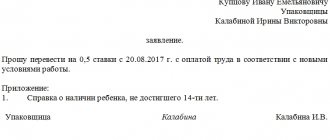Collective bargaining: what is it, deciphering the concept
An exchange of views until a compromise emerges is expected in negotiations of any type. Negotiations with the team are also subject to the rule. Here we are talking about public-social partnership, exchange of opinions also takes place. Agreements with the team and specific clauses of documents are the most common subject for discussion.
The following set of signs is typical for negotiations with several participants:
- Common goal. The parties must develop a solution that meets the interests of each participant.
- Transfer of initiatives between participants. The initiators themselves are also different.
- Equality of both parties in the process.
- No restrictions on the choice of subject of discussion.
After a proposal to start negotiations from one party, the other must give a written response no later than two weeks later.
The procedure is carried out in compliance with the following several principles:
- A ban on making decisions that worsen the rights of workers in comparison with the conditions that were in force before.
- They make decisions voluntarily, but after that the specified rules will be mandatory.
- Respect for the interests of other participants is also mandatory.
- Distribution of powers between full parties.
- Compliance with legislation in force in the Russian Federation.
Another comment to Art. 36 Labor Code of the Russian Federation
1. The definition of collective bargaining is given in ILO Convention No. 154 “On the Promotion of Collective Bargaining” (concluded in Geneva on June 19, 1981). They are understood as all negotiations that take place between an employer, a group of employers or one or more employers' organizations, on the one hand, and one or more workers' organizations, on the other, for the purpose of: a) determining conditions of work and employment; and (or) b) regulation of relations between employers and workers; and (or) c) regulating relations between employers or their organizations and the organization or organizations of workers.
Collective bargaining covers all aspects of the relationship between employees and employers, i.e. There are no issues in relations regarding the use of hired labor that could not be the subject of collective bargaining.
Representatives of the state or local government may take part in collective negotiations in cases provided for by law. In this case, they are full participants in the negotiations (see Article 45 of the Labor Code and the commentary thereto).
In the commented articles Ch. 6 of the Labor Code establishes the general procedure for conducting collective bargaining. It has general meaning and is used for negotiations at any level. The parties to collective bargaining, based on the norms of the commented chapter, independently determine the specific procedure for conducting collective bargaining.
2. Representatives of workers and employers are universal participants in collective bargaining. For relevant representatives, see chap. 4 TC and commentary to it.
Any of the parties has the right to initiate the start of collective negotiations for the preparation, conclusion or amendment of a collective agreement or agreement. A proposal to start collective bargaining is put forward on behalf of representatives of workers or employers by the body whose competence is responsible for making the relevant decision (trade union committee of the primary trade union organization, council of the association of trade unions, executive body of the association of employers or a specific employer, etc.). The procedure for making this decision is determined by the charters and regulations of workers' or employers' (employer) organizations. Putting forward an initiative to conduct collective bargaining by a body or person that does not have proper authority does not give rise to obligations on the other party to enter into negotiations. Employees of the organization and their representatives also have the right to put forward a proposal to begin collective bargaining.
The proposal to start collective negotiations is sent by the initiator to the other party (parties) in writing. A written proposal to initiate collective negotiations must be sent in a way that allows the fact of its receipt by the other party to be recorded (delivery to an authorized person against receipt, sending by post with acknowledgment of delivery, etc.). The party that received the specified proposal is obliged to enter into negotiations within seven calendar days. Entry into negotiations is carried out through the appointment (selection) of persons participating in collective negotiations on its behalf and sending the corresponding decision to the initiator of collective negotiations. The decision to enter into negotiations is made by the body whose competence is responsible for making a specific decision. The procedure for making this decision is determined by the relevant charters and regulations.
3. Collective negotiations begin the next day after the initiator of collective negotiations receives a response that meets the above requirements. The day of the end of collective negotiations is the day of signing a collective agreement, agreement or protocol of disagreements.
4. The commented article excludes the representation of the interests of employees by persons who represent the interests of employers, organizations or bodies controlled by employers, state authorities and local governments, and political parties. Such organizations may include those that are formed with the primary participation of employers or their representatives, executive authorities, local governments, political parties or are directly financed by them. This rule specifies the norms of ILO Convention No. 98 “On the Application of the Principles of the Right to Organize and to Collective Bargaining” (adopted in Geneva on July 1, 1949), according to which workers’ and employers’ organizations enjoy adequate protection against any acts of interference by each other. friend or by their agents or members. In particular, actions intended to promote the establishment of workers' organizations under the dominance of employers or employers' organizations or to support workers' organizations by financing or otherwise with a view to bringing such organizations under the control of employers or employers' organizations are considered interference.
About the right to representation
The first step is for one of the participants to make a decision regarding the need for collective bargaining. Several representatives are invited to realize the goal. Management is represented by employers or other persons with appropriate authority. Employees may have problems making a choice if they do not understand all the nuances.
Conducting a secret ballot if a trade union is not organized in the company or when there is a trade union, but less than 50% of all employees are in it. In the latter case, a secret vote is held to give the trade union the right to appoint representatives of the collective.
A trade union has the right to independently choose members if it includes more than 50% of all subordinates. In companies with several active trade unions, it is permissible to assemble a single body responsible for the expression of opinions at all such events.
Collective negotiations - stages of negotiations
Important!
Collective negotiations are held in 2 cases: when a collective agreement is concluded for the first time, and when the expiration date of the previous collective agreement approaches (no earlier than 3 months).
Collective negotiations are carried out in several stages:
| Collective bargaining stage | Description |
| Stage 1 – Right to representation | Representatives of the negotiating parties are selected. The employer may appoint the head of the company or an authorized person with the right to sign. And the workers act as follows:
|
| Stage 2 – Proposal for negotiations | Negotiations begin with the following actions:
|
| Stage 3 – Clarification of powers | Each representative must be informed of the rights and responsibilities in the negotiations. It is necessary to provide:
|
| Stage 4 – Time, place, regulations | The end date of negotiations is the day of signing the final version of the collective agreement upon reaching agreement between the representatives of the parties. The location of the negotiations and the timing must be agreed upon by the parties in advance. The duration of negotiations should not exceed 90 days. |
| Stage 5 – Discussion of the draft collective agreement | The parties propose issues of concern for consideration and decide which provisions to develop in the collective agreement. If it is decided to make adjustments to the original text of the contract, they are recorded in the document. Even if the previous collective agreement has expired, the old agreement remains in effect during the negotiation period. |
| Stage 6 – Conclusion of a new collective agreement or opening of a collective labor dispute | A new draft collective agreement is approved when all the issues that have arisen have been resolved and the parties have reached an agreement. Both parties sign the project - on the part of the employees there must be a signature of each participant as a member of the representative body. If some issues cannot be resolved, a collective dispute opens. |
| Stage 7 – Updating the collective agreement | The approved document is sent to the Department of Labor (within 7 days after signing the project). The territorial labor control body cannot refuse to register a document. |
Main stages of collective bargaining
After selecting representatives of the parties, the stages of negotiations can be divided into several stages (see Table 1).
Table 1. Stages of collective bargaining
| Stage | Content |
| Direction of the proposal | A person endowed with the appropriate initiative makes a proposal to negotiate. In this case, a written appeal is sent to the second interested party. The other party is given a maximum of a week to prepare for the event and prepare a response. It is allowed to start the event the next day after receiving a response. The latter involves the use of an order form, which states the convening of a commission, which should control the process. |
| About clarification of powers | A separate agreement between the parties is reached regarding the rights and obligations of the parties when participating in the event. Attention is paid to issues that may cause controversy:
|
| Time, place and regulations | The location and timing are agreed upon separately. The dialogue itself is subject to the same rules. The event officially ends on the same day when the latest version of the agreement is signed. The maximum duration of the negotiations themselves is up to three months. |
| Discussion of the draft agreement | This is the negotiation itself. When specific changes are mentioned, they are added directly to the text of the document. In this case, the old collective agreements remain valid even if their term has expired. |
| Conclusion and updating of a new agreement | The project is finally approved when all issues regarding its content are resolved. Each participant interested and present at this event must sign the document. In the absence of compromise, the final stage becomes a labor dispute. Actualization can also be called the final part. The signed text is sent to representatives of the Department of Labor. The main thing is to complete the process no later than a week after signing. There are no refusals to register; this is a formal procedure. |
Article 37. Procedure for conducting collective bargaining
Representatives of the parties participating in collective negotiations are free to choose issues related to the regulation of social and labor relations.
(as amended by Federal Law No. 90-FZ of June 30, 2006)
Two or more primary trade union organizations, collectively uniting more than half of the employees of a given employer, by decision of their elected bodies, can create a single representative body for conducting collective bargaining, developing a single draft collective agreement and concluding a collective agreement (hereinafter referred to as the single representative body). The formation of a single representative body is carried out on the basis of the principle of proportional representation depending on the number of trade union members. At the same time, it must include a representative of each of the primary trade union organizations that have created a single representative body. The single representative body has the right to send to the employer (his representative) a proposal to begin collective negotiations on the preparation, conclusion or amendment of a collective agreement on behalf of all employees.
(Part two as amended by Federal Law No. 90-FZ of June 30, 2006)
A primary trade union organization that unites more than half of the organization’s employees, an individual entrepreneur, has the right, by decision of its elected body, to send to the employer (his representative) a proposal to begin collective bargaining on behalf of all employees without first creating a single representative body.
(Part three as amended by Federal Law No. 90-FZ of June 30, 2006)
If none of the primary trade union organizations or collectively the primary trade union organizations that wish to create a single representative body unite more than half of the employees of a given employer, then the general meeting (conference) of workers by secret ballot may determine the primary trade union organization that, with the consent of its elected body, is instructed to send the employer (his representative) a proposal to begin collective bargaining on behalf of all employees. In cases where such a primary trade union organization has not been determined or the employees of a given employer are not united in any primary trade union organizations, the general meeting (conference) of workers by secret ballot may elect another representative (representative body) from among the employees and vest him with the appropriate powers.
(Part four as amended by Federal Law No. 90-FZ of June 30, 2006)
The primary trade union organization, a single representative body or other representative (representative body) of workers, vested with the right to take the initiative to conduct collective negotiations in accordance with parts two to four of this article, are obliged, simultaneously with sending the employer (his representative) a proposal about the start of these collective negotiations inform all other primary trade union organizations that unite employees of this employer, and within the next five working days create, with their consent, a single representative body or include their representatives in the existing single representative body. If within the specified period these primary trade union organizations do not inform about their decision or refuse to send their representatives to the single representative body, then collective negotiations begin without their participation. At the same time, primary trade union organizations that do not participate in collective negotiations retain the right to send their representatives to a single representative body within one month from the date of the start of collective negotiations. In the case where the representative of workers in collective bargaining is a single representative body, the members of this body represent the side of the workers in the collective bargaining commission.
(part five as amended by Federal Law dated June 30, 2006 N 90-FZ)
The right to conduct collective bargaining, sign agreements on behalf of workers at the level of the Russian Federation, one or more constituent entities of the Russian Federation, industry, territory is granted to the relevant trade unions (trade union associations). If there are several trade unions (associations of trade unions) at the appropriate level, each of them is given the right to representation in a single representative body for collective bargaining, formed taking into account the number of trade union members they represent. In the absence of an agreement on the creation of a single representative body for conducting collective negotiations, the right to conduct them is granted to the trade union (association of trade unions) that unites the largest number of members of the trade union (trade unions).
(as amended by Federal Law No. 90-FZ of June 30, 2006)
The parties must provide each other no later than two weeks from the date of receipt of the relevant request with the information they have necessary for conducting collective bargaining.
Participants in collective bargaining and other persons associated with collective bargaining must not disclose information received if this information relates to a secret protected by law (state, official, commercial or other). Persons who disclosed the specified information are brought to disciplinary, administrative, civil, and criminal liability in the manner established by this Code and other federal laws.
(as amended by Federal Law No. 90-FZ of June 30, 2006)
The timing, place and procedure for holding collective negotiations are determined by representatives of the parties who are participants in these negotiations.
Recording of collective negotiations
Documentary and written recording for such events acts as a mandatory requirement. The procedure is accompanied by a document that includes the following information:
- signatures of the participants when everything is completed;
- number of positive and negative votes;
- a description of the citizens who spoke on each issue;
- description of the agenda;
- composition of the commission. It is necessary to indicate the name of each person along with their position;
- time of negotiations, exact date;
- name of the meeting;
- exact protocol number.
How are collective bargaining protocols recorded?
Collective agreements must be documented, since the procedure for their implementation is regulated by law. During negotiations, a protocol is drawn up, including the following information:
- protocol registration number;
- title of the meeting;
- time and date of negotiations;
- composition of the commission (last names, first names, patronymics, positions);
- agenda;
- speaker on each issue;
- the decision taken on each issue;
- the number of votes “for” and “against” (in case of voting) on all issues separately;
- signatures of the participants (at the end of negotiations).
Participation in negotiations and guarantees with compensation for interested parties
Collective negotiations are organized based on Article 39 of the Labor Code of the Russian Federation. In addition to the interested parties themselves, the procedure allows for the participation of intermediaries, specialists and experts. All these persons have the right to guarantees with additional compensation described at the legislative level.
The following guarantees ensure the successful holding of the event in any conditions:
- Maintaining wages for a specified period.
- Release from main work for the duration of this procedure. No more than three months.
All persons are guaranteed compensation for any costs associated with participation in negotiations. The amounts and sources of compensation are determined on several grounds:
- agreement;
- collective agreement;
- legislation.
The inviting party usually pays for the services of experts and any intermediaries. The exception is when important documents provide for other conditions.
All employees directly involved in the process can count on additional guarantees. For example, team members cannot be subject to disciplinary action while the event is taking place. The ban applies to dismissal and transfers to other positions. Dismissal is permissible only if it is proven that the citizen has committed a serious offense that allows for the application of punishment.
Collective negotiations and their purposes
Collective bargaining (CB) is considered to be one of the most important forms of social partnership. This term is defined in Article 2 of Convention No. 154 of the International Labor Organization, and it means:
- negotiations taking place between employers (or their organizations) and workers, who may also be organized into organizations, to determine working and employment conditions;
- settlement of relationships that arise between the above parties.
During collective bargaining, trade unions and other participants in the process regulate the development and conclusion of collective agreements, which are designed to ensure the right to social protection of workers and serve to resolve labor disputes.
The main purpose of conducting a CP is to conclude a collective agreement or agreement, as well as to introduce changes or additions to such documents in order to:
- determine the working conditions of workers, their employment and other rights;
- regulate relations between workers and employers;
- ensure the settlement of relationships that arise between organizations of employers and workers.
Who is prohibited from taking part in negotiations?
Permission to participate in negotiations with the team is described in Article 36 of the Labor Code of the Russian Federation. This is necessary to ensure that the procedure is carried out as impartially as possible. And so that workers' rights are fully protected. Prohibitions usually apply to the following persons:
- Parties and representatives of executive authorities.
- Organizations that depend on the leader directly or indirectly.
- Workers who want to participate on behalf of the team, but in fact represent the interests of the employer.
Collective bargaining – who cannot become an employer’s representative
Employees of the enterprise and the employer must clearly determine their representative for collective bargaining. Persons who represent the interests of the employer do not have the right to simultaneously represent the interests of workers.
In addition, the following cannot participate in collective bargaining:
- political parties;
- representatives of local government;
- executive authorities;
- organizations established or sponsored by the employer.
What information can be recorded in collective agreements?
Any such document is subject to the principles of appropriate regulation. Agreements may consist of the following points:
- By strikes. If the requirements are met, they are expected to be waived.
- Monitoring compliance with the terms of the document, changing it, making additions if necessary.
- Payment for food.
- Rest for family members.
- Benefits for employees who combine study and work.
- Ecology and labor safety.
- Respect for the rights of subordinates in the process of property privatization.
- Improved working conditions for certain categories.
- Working and non-working hours.
- Mechanism for regulating wages.
- Payment of benefits.
- The labor system as a whole.
- Other nuances related to this document can be provided.
The area of regulated relations allows us to distinguish several types of agreements:
- territorial;
- professional;
- intersectoral or sectoral;
- regional;
- general
Documents can be two- or three-party, depending on how many participants are interested in the results. The level of agreement may also influence how many participants there will be in the future.
The timing of agreements and the procedure for processing documents are regulated by a special commission that meets for this event. This association is also responsible for developing the draft documents themselves based on the agreements. If the provisions do not violate the requirements of the current Legislation, they can equally address labor and socio-economic issues.
The procedure for adopting a collective agreement
A collective agreement is a form of regulation of labor relations.
Its content and structure are determined by the parties: the employer or the employees. The agreement may apply to the entire company or to a separate branch or representative office. A collective agreement may regulate issues of remuneration, provision of benefits, professional training of employees, labor protection, social security, etc. It may also stipulate the obligations of employees: to comply with the daily routine, refuse strikes, etc.
There is no requirement to conclude a collective agreement at the enterprise and there is no liability for its absence. Employees may enter into such an agreement on their own initiative.
Several chapters of the Labor Code are devoted to the procedure for concluding a collective agreement at an enterprise and consideration of the concept of this document (Chapters 6, 7, 61). The procedure for adopting a collective agreement can be briefly summarized in the following steps:
- One of the parties to labor relations takes the initiative to develop and sign a collective agreement.
- The initiator sends a written proposal to the other party to negotiate . It is advisable to record the fact that the letter was transmitted from employees to the employer’s office.
- The recipient of the proposal has a week to provide a formal response . According to Art. 36 of the Labor Code, the response must contain a list of delegates to participate in the negotiation process. The employer does not have the right to refuse to participate in negotiations, otherwise he may be subject to administrative liability.
- A special commission is being created to develop a draft agreement.
- Collective bargaining is underway . Their start is counted from the first day after receipt of a response from the second party. The date and place of negotiations are determined by the parties by agreement. During negotiations, the parties should determine the provisions of the contract and find out what contradictions they have.
- Based on the results of the negotiations, a final protocol is drawn up.
- All problematic issues are recorded in the protocol of disagreements.
- The parties concentrate on resolving contradictions . For this purpose, new meetings may be appointed, the number of which is not limited, or the provisions of Art. 61 Labor Code.
- A collective agreement is signed . Even if the parties were unable to agree on all issues, the agreement must be signed within 3 months from the start date of negotiations. Art. speaks about this. 40 of the Labor Code.
The procedural aspect of concluding a collective agreement is quite important, since this will not allow the document to be declared invalid and will preserve the employer’s right to tax benefits.
On collective labor disputes in legislation
The reason for such a dispute is a situation where the employer actually refuses to take into account the opinion of the professional association. You can choose different dates to initiate such an event:
- When a protocol of disagreements is signed, after negotiations.
- The employer made a decision, but did not inform his subordinates about it within the specified period.
- The day on which employees are notified of any denied claims.
The disagreements themselves cannot yet be called a labor dispute, because the chance for their settlement still remains between the parties.
A dispute takes shape when all the ways to reach a compromise have already been tried in practice, but have not yielded any results. The legislation determines the parties who can participate in such a process.
The following persons are authorized to represent management:
- organizations of professional associations;
- senior staff;
- other persons vested with appropriate authority.
Procedure for preparing and adopting a collective agreement
The Labor Code does not stipulate the procedure for developing a collective agreement in sufficient detail. In Art. 42 of the Labor Code indicates the possibility of resolving this issue through special or regional regulations. In particular, the procedure for adopting a collective agreement is given attention in the Law “On Trade Unions” of 1996 No. 10-FZ, as well as in sectoral agreements between the local administration and trade unions and other municipal acts.
The procedure for conducting negotiations on the content of the collective agreement and the meeting of the commission is prescribed in Art. 37 of the Labor Code. During the negotiations, various proposals from participants are collected and consolidated. Participants in the negotiation process themselves have the right to determine the conditions for holding meetings.
When conducting collective bargaining, the employer is obliged to release its participants from their main jobs while maintaining their average earnings (in accordance with Part 1 of Article 39 of the Labor Code) and provide employees with complete information necessary to conclude an agreement (in accordance with Part 2 of Article 22). The employer does not have the right to punish the persons participating in the negotiations, transfer them to another job, or dismiss them on its own initiative.
Part 3 art. 39 of the Labor Code provides that the costs of participation in collective bargaining may be compensated in the manner established by this document.
Payment for the services of invited experts and lawyers is carried out at the expense of the inviting party.
The parties have the right to request information about the progress of negotiations from their opponents , who are given 2 weeks to process the request and provide an official response. The progress of the commission meeting and the proposals of the parties must be recorded in writing.
Often the parties cannot come to an agreement at the first meeting, then they draw up a protocol of disagreements and schedule a new meeting.
If the parties fail to resolve the disputed issues, they can resort to the help of a mediator or contact an authorized authority for the settlement of labor disputes.
The stages of the negotiation process regarding a collective agreement are usually as follows:
- The commission agrees on the content of the collective agreement . Typically, initiatives at this stage belong to employees as the most interested party. At the same time, the employer’s representative evaluates the content of proposals for compliance with local regulations and labor legislation. The collective agreement may include such issues as the form, system and amount of remuneration; benefits and compensation paid; mechanism for regulating wages; working time and rest time; retraining; environmental safety, etc. This list is not exhaustive or mandatory. The provisions of the collective agreement should not duplicate the provisions of the employment contract and may only contain conditions that improve the conditions of employees (for example, additional leaves and compensation).
- The total amount of funding for guarantees provided to employees is determined . It depends on the current financial condition of the company and the profitability of the operation.
- Standards and specific amounts of guarantees are established for previously determined positions.
- The obligations of employees under the contract are determined (for example, refusal to strike, subject to the employer’s compliance with the terms of the contract).
- Procedural issues are being resolved . In particular, the duration of the agreement, the procedure for its application, amendments and conclusion.
The validity period of the collective agreement cannot exceed three years (according to Part 1 of Article 43 of the Labor Code of the Russian Federation).
Read more about labor disputes with teams
This phenomenon has its own characteristics, like other types of interaction between stakeholders:
- Method of settlement.
- Subject and reasons.
- Subject composition.
In actions to resolve such a conflict, a large number of participants is permissible:
- prosecution authorities;
- regional judges;
- Federal and regional level of bodies representing the executive branch;
- Rostrud and other organizations performing similar functions;
- labor arbitration operating on a temporary or permanent basis;
- intermediaries;
- conciliation commissions.
Who approves the collective agreement
The collective agreement is approved by the negotiators. It is subject to registration with the regulatory authority selected in the region. But the executive body does not approve collective agreements and does not have the right to make amendments to them. He can only notify the employer of violations of the law committed in the contract.
The lack of full agreement among the parties on the content of the collective agreement does not relieve them of the obligation to sign the document within the established time frame, at least in the part where the parties managed to come to an agreement. The remaining provisions can be included in the contract through the signing of additional agreements.
Before signing a contract, the parties can contact specialists to conduct a legal analysis. During this analysis, the lawyer pays attention to the compliance of the contract provisions with labor law standards and ensures that the contract does not worsen the working conditions of employees.
Subject and reasons for the dispute
Disagreements between stakeholders are the subject of much of the negotiation. At the local level, such a dispute can be caused by several of the following reasons:
- The employer takes into account the opinions of employees when drawing up local regulations.
- Drawing up agreements with the team, monitoring the terms. Changes are considered if necessary.
- Establishment of working conditions, including remuneration for work.
Adjustments for these factors are acceptable when the level of interaction increases.
On the validity period of collective agreements
1-3 years is the standard validity period for most documents issued as a result of the event. But collective agreements can change this rule:
- The agreement is extended if at the time of collective negotiations the main document is no longer active.
- When a company is liquidated, the information remains relevant until the procedure is completed.
- The agreement continues to be valid if the owner of the enterprise changes.
- Reorganization also does not affect the agreement and its validity.
How is the start date of collective bargaining determined?
A special procedure is provided for in the legislation for determining the terms and dates of collective bargaining. In particular, they can be initiated by any of the parties to the labor relationship. However, she must give notice to the other party. The other party to the relationship must respond to this notification within seven days from the date of receipt of the letter or other notification.
The immediate day of the start of collective negotiations is defined as the day following the day of receipt of the response in question by the party initiating the negotiations. Violation of these deadlines by the employer may entail administrative liability in accordance with Article 5.27 of the Code of Administrative Offenses of the Russian Federation.
If the day falling on the day of the start of collective negotiations is a day off for the employer or trade union, then the day of their start is considered the next closest working day for both parties.
What if the employer refuses to participate in the event?
The law does not describe the reasons why management may refuse. Violations of the standard course of negotiations, which continues to apply in all situations, are prohibited. When violations occur, consequences arise from Article 54 of the Labor Code of the Russian Federation:
- refusal to sign the protocol drawn up based on the results of collective negotiations;
- the decision has been made, but they refuse to sign the adjustments;
- Participation in the negotiations themselves is postponed.
Employers are fined if such deviations are detected. The penalties will range from 1 to 3 thousand rubles.
https://youtu.be/Yvt52okvC_E
Protocol
The procedure for conducting collective bargaining is clearly reflected in the minutes. Logging of this procedure is mandatory. The document must consist of the following data:
- Time and place of the event.
- Members of the commission, their powers and responsibilities, indicating their full names and positions.
- Document Number.
- Theme of the meeting, results and decisions made.
- Results of voting on a particular issue.
- Signatures of all meeting participants.









